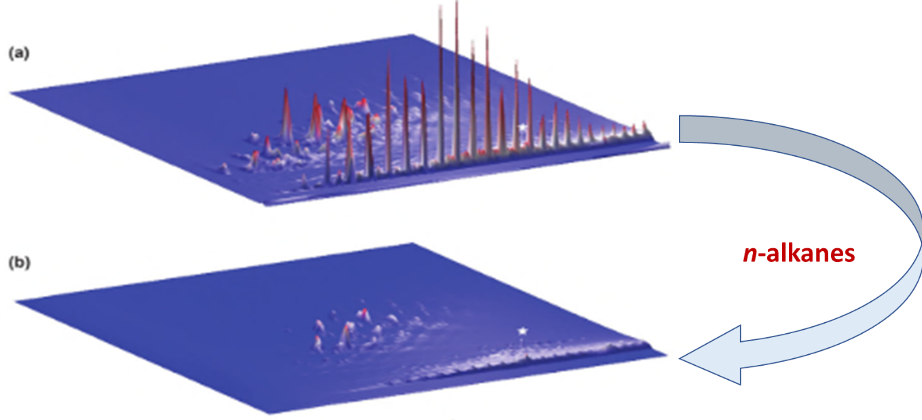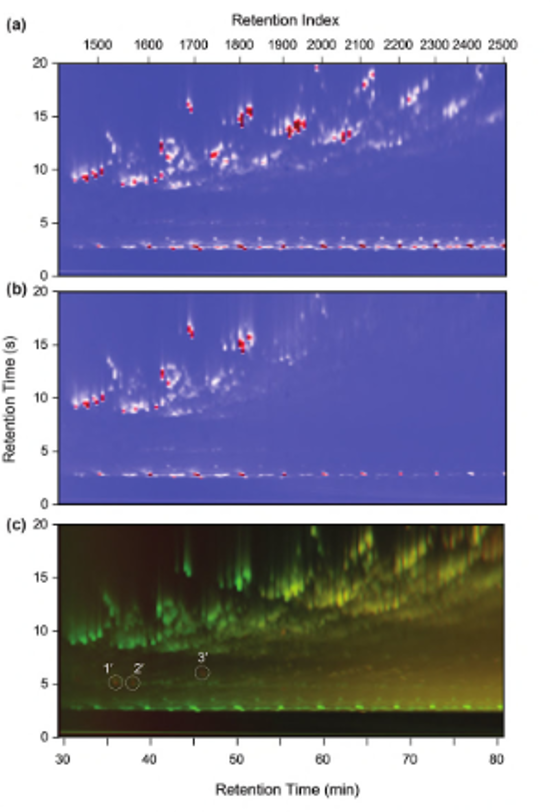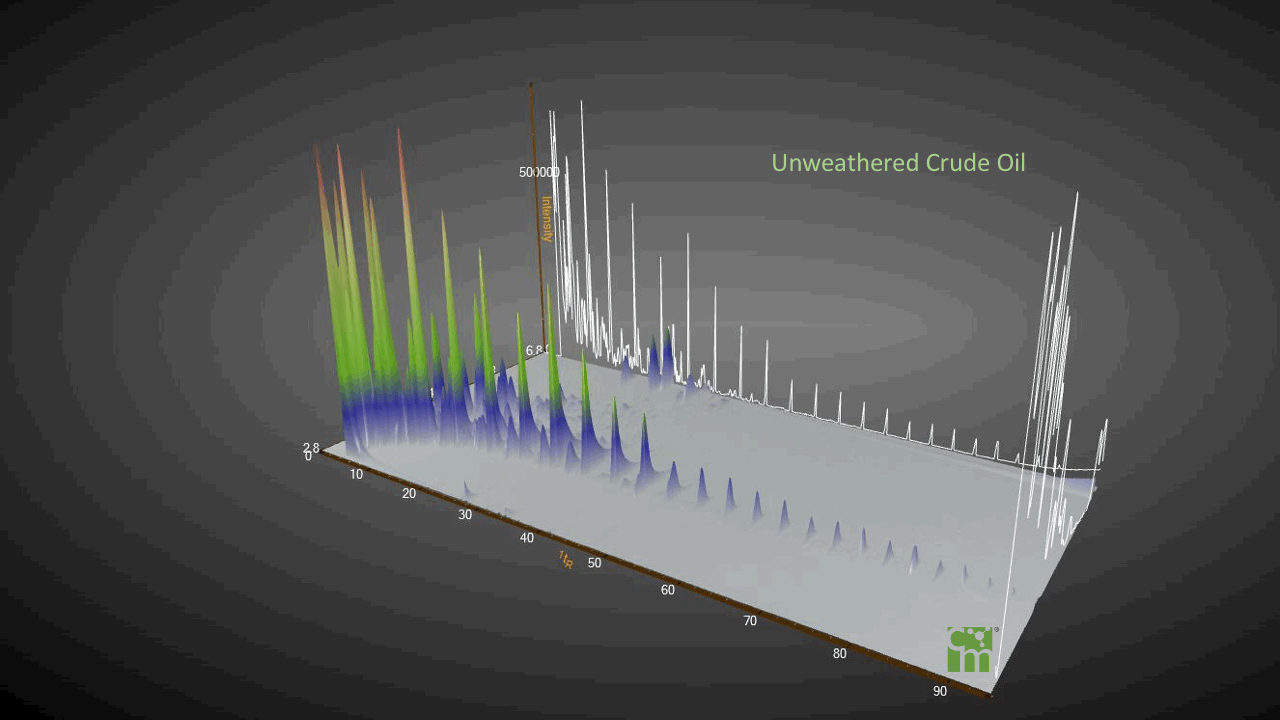As a newly initiated team member of Chemistry Matters Inc. (CMI), it’s impressive to be working with a consulting firm that not only has a breadth of knowledge in geochemistry but can translate this knowledge into real world GCxGC applications. One of the key traits that distinguished CMI from any organization is our ability to refine complex and technical academic literature into accessible applications for our industry partners. The geoforensic work on oil weathering patterns through a GCxGC perspective highlights the perspective our consulting group brings on assessing real oil spill and emergency spill response situations.
Oil Spill Weathering
In order to understand how we apply this breath of geochemical knowledge and GCxGC expertise towards real oil spill and emergency response situations, we need to first understand what effect weathering has on oil. When petroleum is introduced to the environment, the physical and chemical characteristics of petroleum hydrocarbons interact with the physical and biogeochemical features of the surrounding environment. These temporal changes are reflected by the rate of sedimentation, in-situ biodegradation, dispersion, emulsification, evaporation and oxidation. The sum of these physical and biological processes results in what we call "weathering" of the oil, which can be monitored by determining the changes in chemical composition and physical characteristics over time. This can also be referred to as the fate and transport of the oil in the environment.
As a consulting forensic geochemist, having the ability to illustrate the extent of petroleum weathering gives insight into remediation development and source attribution. GCxGC is a powerful tool in geoforensics to investigate weathering as it offers unparalleled chromatographic separation, peak capacity and has been used in recent years to resolve individual components of complex petroleum spills. In terms of remediation, understanding the extent of weathering is important as the breakdown of petroleum generally decreases it’s bioavailability.
In this blog post, I’ll be summarizing an article presented by Nelson et. al (2006) to demonstrate how CMI integrates academic resources such as these into our own GCxGC applications for monitoring petroleum weathering.
Nelson et. al (2006) collected samples from a spill that occurred in 2003 into Buzzards Bay (Massachusetts, USA) when the single-hulled barge Bourchard 120 grounded. To assess the environmental impact and extent of weathering, samples were collected on day 12 and day 179 after the accidental release and analyzed on GCxGC/FID. From visual inspection of the contour plots (shown below), it was evident that weathering (biodegradation, evaporation and washing) had the most pronounced effect on n-alkanes, alkylated naphthalenes, and phenanthrenes (Figure 1). This type of modelling, is extensively used at CMI to provide our clients with a visual representation of the extent of weathering that has occurred within their site.

Figure 1 – GCxGC 3-D chromatogram of sample extracts from Bouchard 120 oil-covered rocks collected (a) 12 days after the spill (b) 179 days after the spill. The conserved 17α(H), 21β(H)-hopane is marked with a white star. Figure from Nelson et al (2006).
An important visual tool in a geochemist’s arsenal is overlaying the two chromatograms together to illustrate the magnitude of compound specific degradation. For the Bourchard 120 spill, 'difference chromatograms' were obtained by normalizing both chromatograms to a biomarker (17α(H), 21β(H)-hopane) that is resistant to weathering followed by subtraction of the day 179 chromatograms from day 12 chromatograms. The difference illustrates all the compounds and classes that were degraded over time. Ratio plots were constructed by dividing the day 12 chromatograms by the day 179 chromatograms. The plots illustrate which compounds underwent the most degradation. Addition chromatograms illustrated the compounds that were completely removed (green) or were not present in the day 12 sample (red - degradation bi-products) and compounds present in both chromatograms are colour coded yellow. Compounds labelled 1, 2 and 3 are example of compounds not present at day 12. The chromatograph demonstrates a transition from n-alkanes to polyaromatic hydrocarbons (PAHs). This is expected as PAHs exhibit more resistance to weathering (biodegradation, evaporation and washing) compared to the more volatile lower molecular weight paraffins. While the majority of alkanes (20 – 100%) were degraded, hopane & sterane abundances changed very little, demonstrating their efficacy as a biomarker for this petroleum source.

Figure 2 – GCxGC contour chromatogram (a) difference chromatogram (b) ratio chromatogram (c) addition chromatogram. Peak intensities in (a) and (b) are colour coded from white to red (most abundant). For plot (c) all peaks present at day 12 are assigned green; peaks from day 170 are assigned red; compounds present in both are assigned yellow. Figure from Nelson et al (2006).
Summary
In summary, this blog post is intended to highlight how we Chemistry Matters apply the fundamental knowledge discovered in academia towards the application required for real world case studies for our clients. We apply these techniques routinely during our oil spill emergency response. This also highlights the uniqueness of our consulting firm, as we are developing novel GCxGC approaches to meet the high quality data and interpretation that industry requires.
Call us to see how GCxGC and our oil weathering analysis can be applied to your site or emergency spill response.
References
Nelson, R.K.; Kile, B.M.; Plata, D.L.; Sylva, S.; Xu, Li.; Reddy, C.M.; Gaines, R.B.; Frysinger, G.S.; Reichenbach, S. Environ. Forensics. 2006; 7(1); 33-44 (https://www.tandfonline.com/doi/abs/10.1080/15275920500506758)


-1.png?width=859&name=Sample%20%231%20(2)-1.png)
.jpg?width=859&name=Archery%20photo%20(3).jpg)